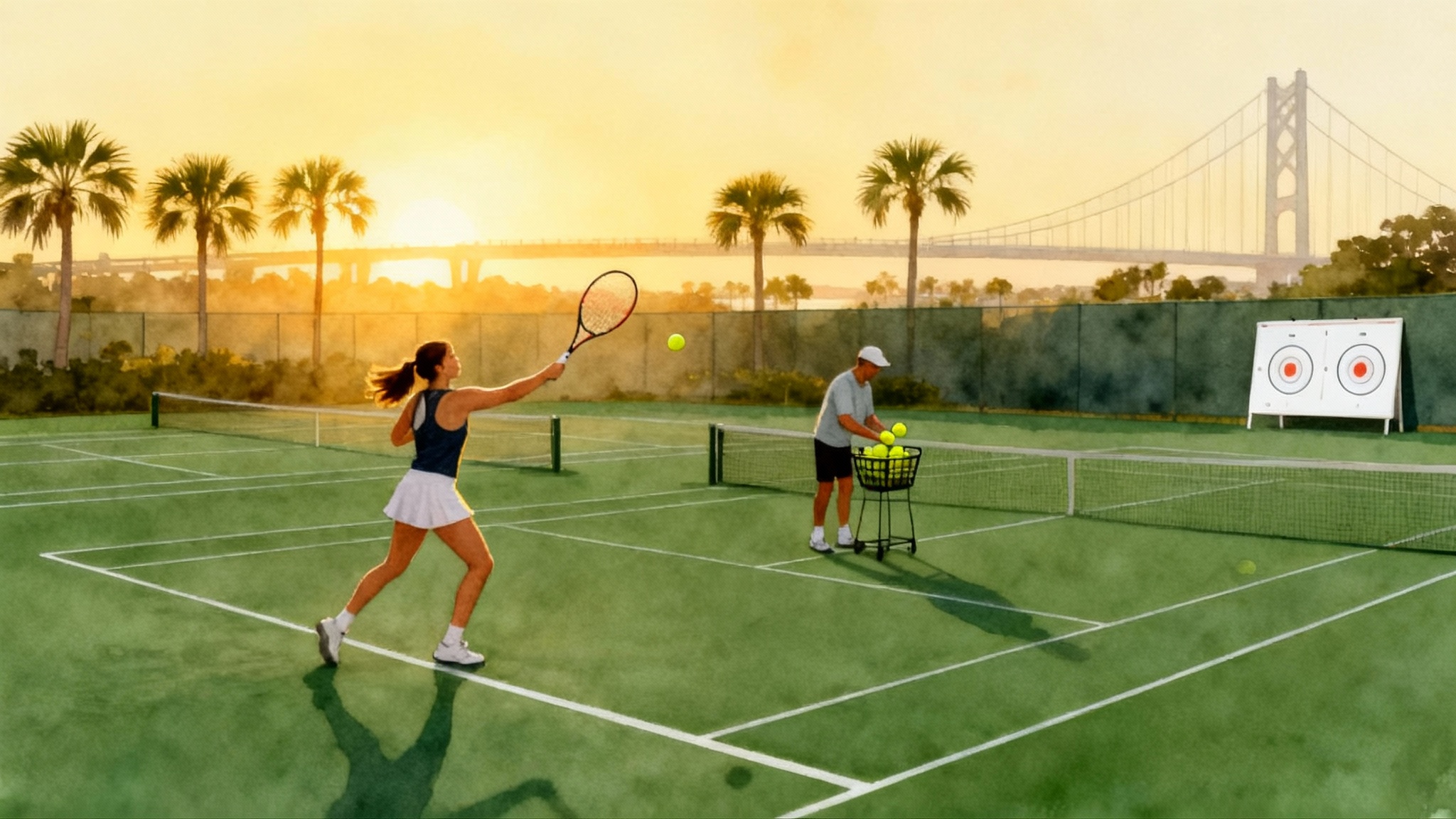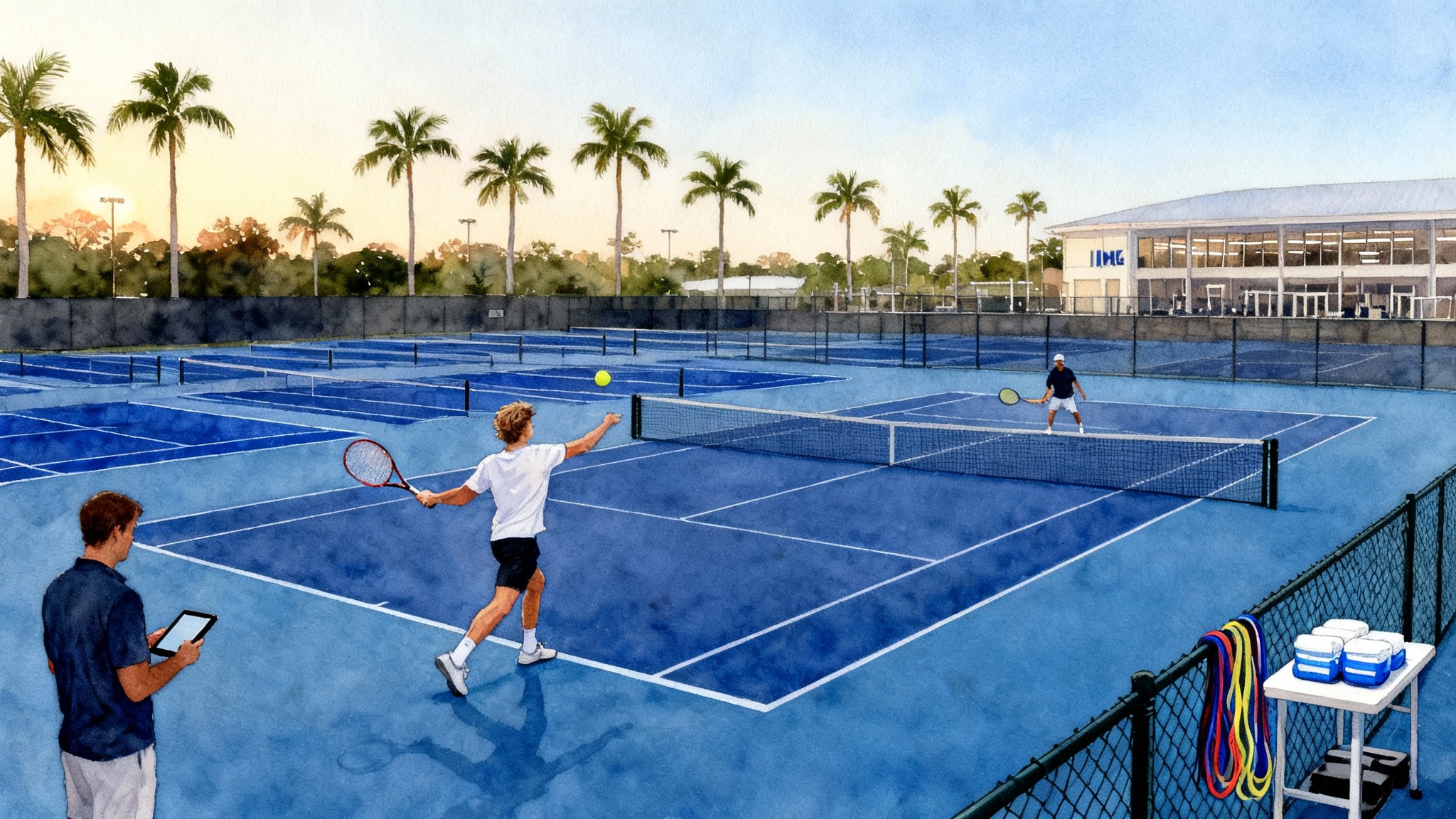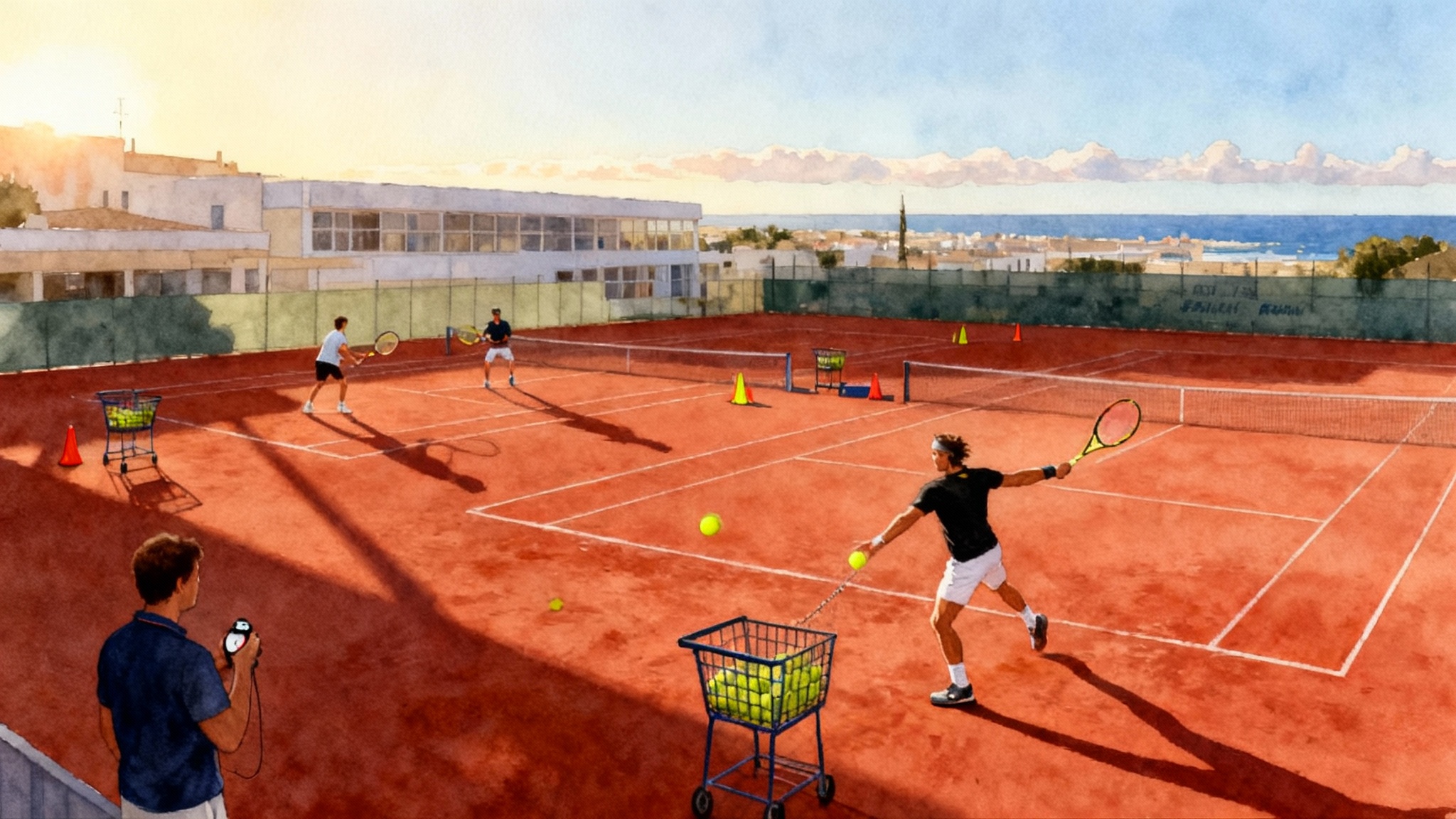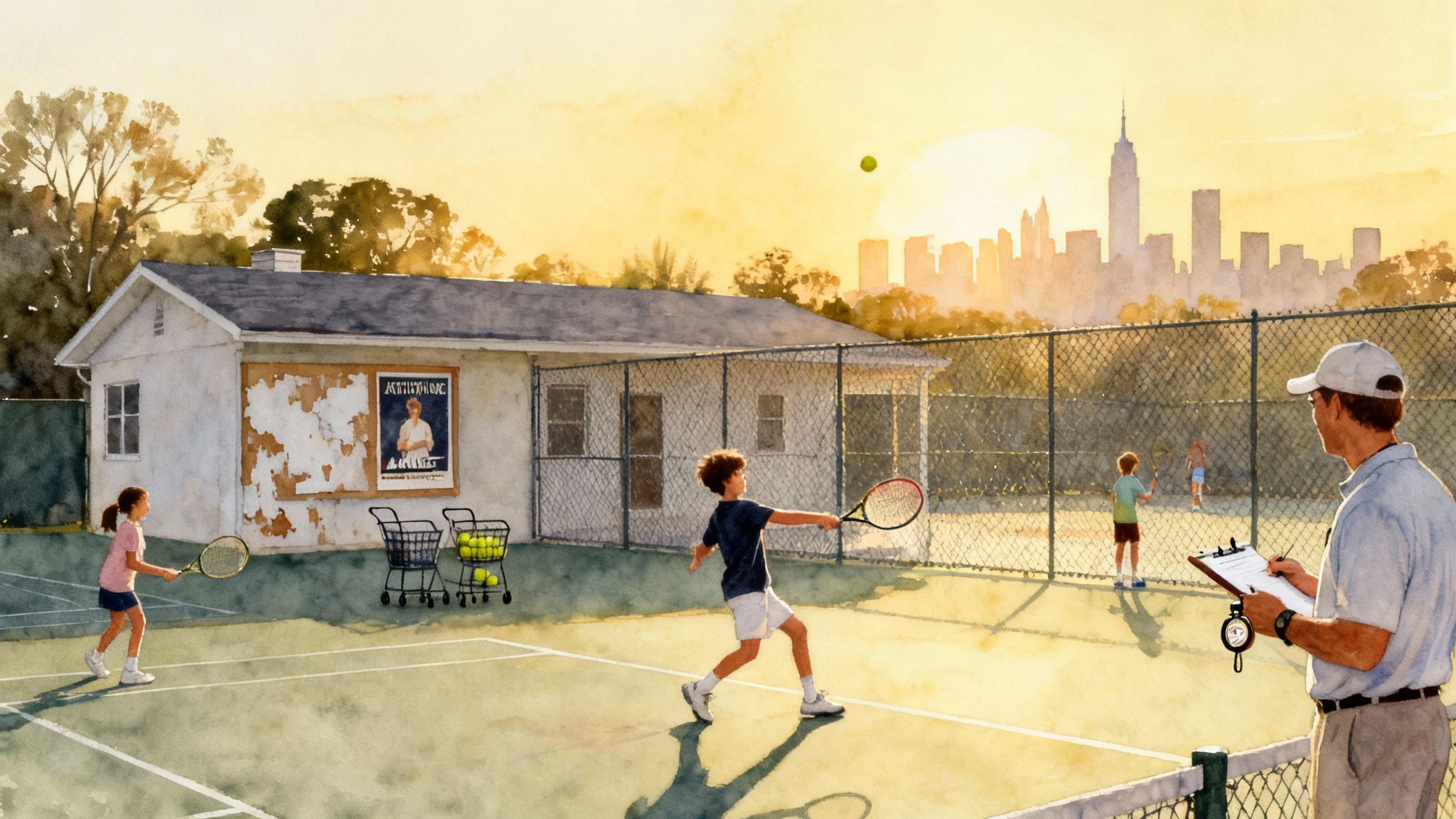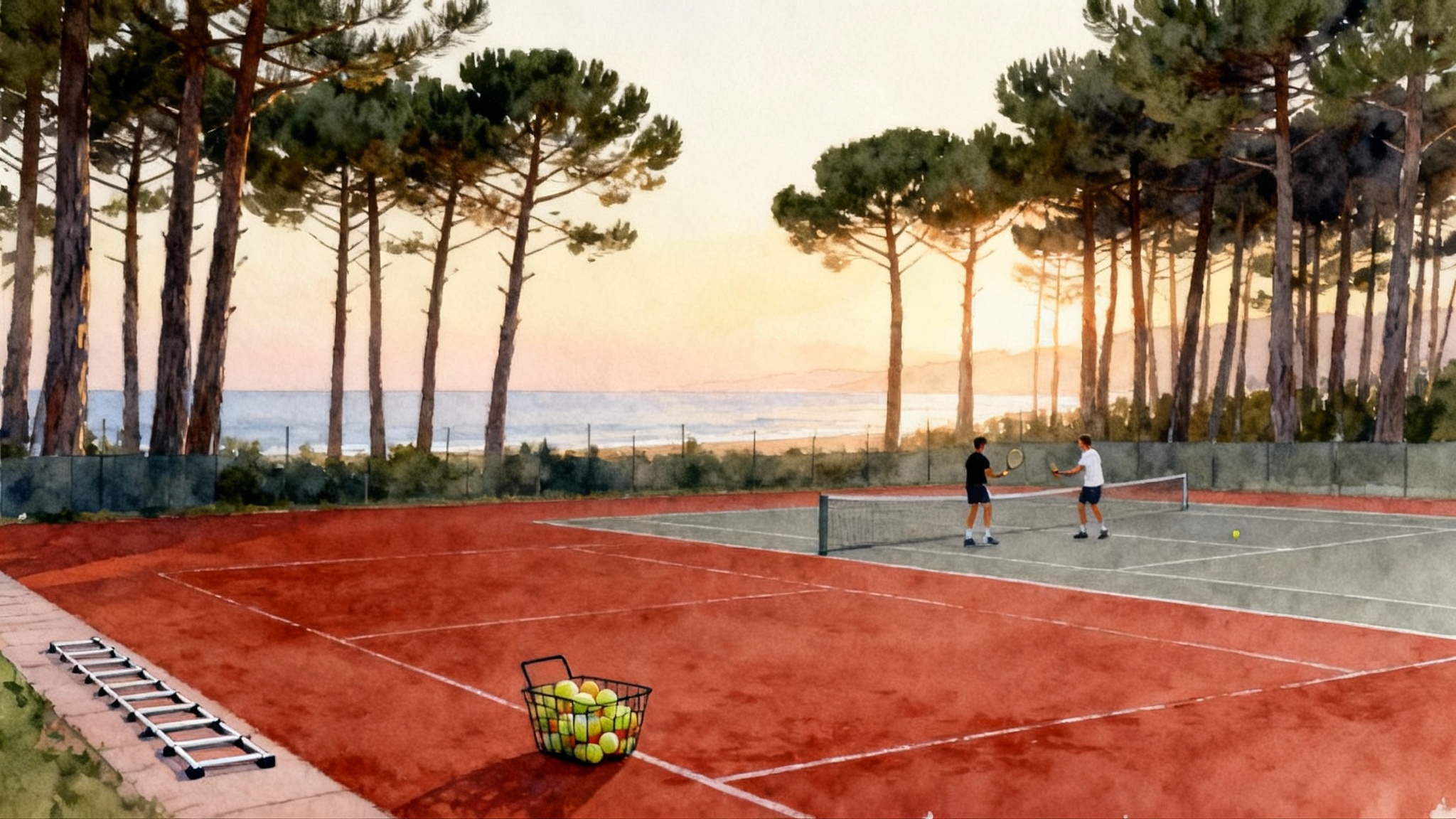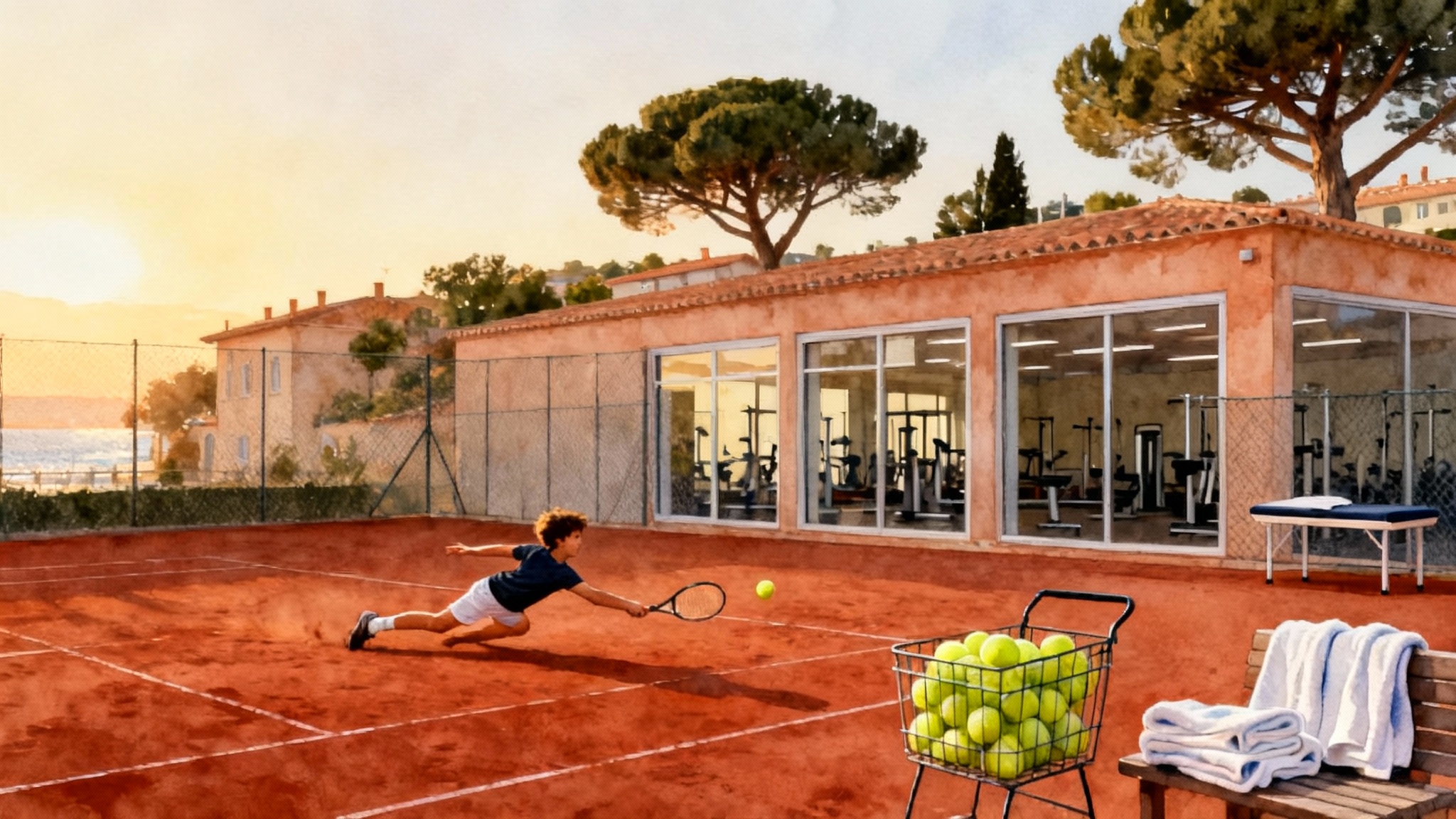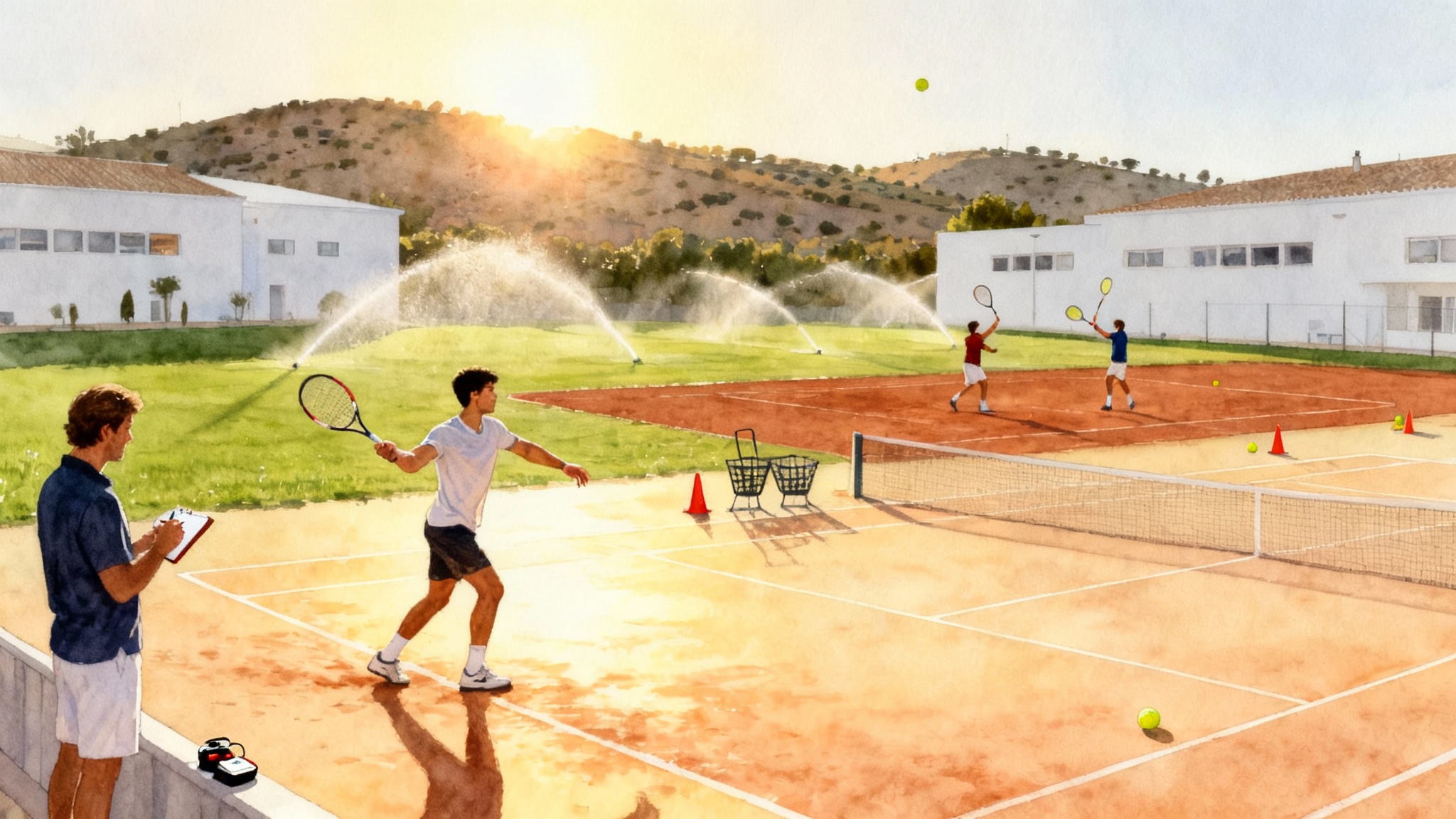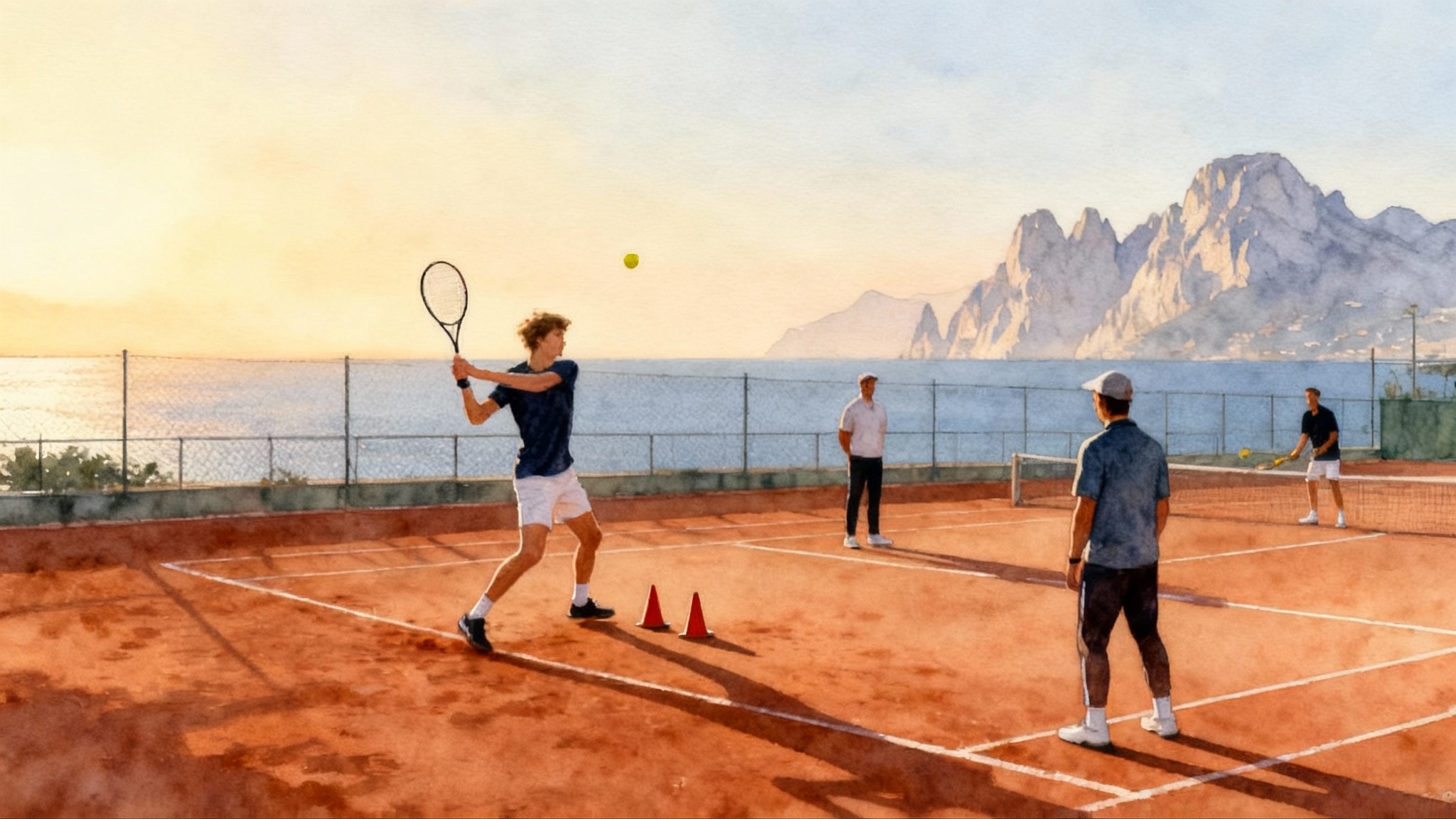How Emilio Sánchez Academy Forged Dimitrov’s Revival
Grigor Dimitrov’s 2007 move from Haskovo to Barcelona’s Emilio Sánchez Academy set the base for his modern game. We trace the clay-first ASC360 method, the shift to Mouratoglou, and how that blend resurfaced in his 2024 surge.
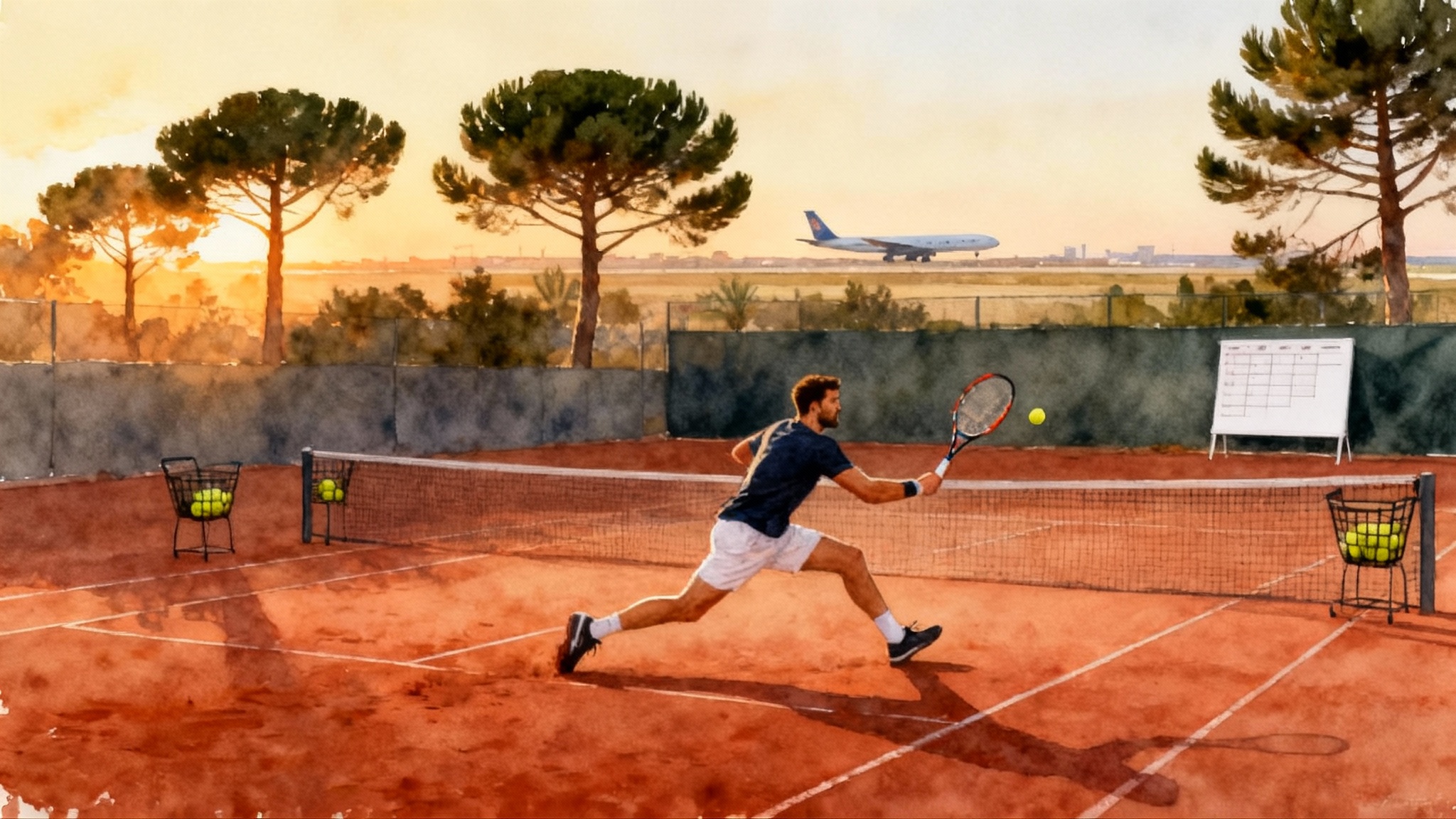
From Haskovo to Barcelona: the decision that changed a career
Grigor Dimitrov was a gifted kid in Haskovo with a one handed backhand that turned heads, and a father who coached him with care and ambition. By 2007 the ceiling at home was clear. He needed tougher daily opponents, a structured pathway, and a court culture that would ask more of his legs than his hands. The choice was Barcelona, where the Emilio Sánchez Academy, also known as Sánchez Casal, offered a boarding school model and a method that had already shaped pros. For families considering this route, study the campus and structure in our Emilio Sánchez Academy Barcelona profile.
Relocating at sixteen is not a romantic leap. It is repetition, early alarms, and a new language. Dimitrov’s first months in Barcelona were not about winning junior trophies. They were about learning to suffer well on a red clay rectangle. The academy’s days were long. Mornings on footwork and patterns, school in the middle, then more tennis and strength work before study hall. Without that rhythm, talent floats. With it, talent compacts into something that can last five sets.
The ASC360 method: why clay first works
The academy’s blueprint is the ASC360 Tennis System, a whole player framework that treats development as the sum of technical, tactical, physical, and mental pillars. The system is not a slogan. It assigns time and measurable goals to each pillar, and it starts on clay to harden decision making and legs. You can read the program’s backbone in the academy’s own write up: ASC 360 Tennis System.
Clay courts slow the ball and stretch the rally. That extra second forces better choices, cleaner spacing, and a commitment to height, spin, and depth. For Dimitrov, who already had feel, the clay first approach translated into three durable upgrades:
- Footwork economy: fewer decorative steps, more posture saving recovery. Coaches tracked how often he set the right foot behind the ball on wide forehands and whether his hips returned to neutral before the next shot.
- Shot tolerance: a target of eight to ten neutral balls per rally without risk, not as a ceiling but as a promise to earn attacks. Miss after six and the set piece resets. Make twelve and you earn freedom in the next pattern.
- Transition clarity: approach on a short cross, close with a first volley into the open lane, then finish with a shoulder high forehand. On clay this is a three shot sequence. On hard courts it becomes a two shot punch.
ASC360 sessions had a simple look and a precise purpose. A common morning block for Dimitrov in those years might read like this:
- Warm up and mobility, then shadow swings with split step timing at the service line, five sets of twenty.
- Crosscourt forehand tolerance drill: fifteen minutes at medium speed with a height window above net strap, then ten minutes at higher pace with targets deep and middle third.
- Two on one neutral pattern: Dimitrov on the run, two coaches alternating crosscourt, with one change of line allowed every four balls. Goal is posture on the seventh shot and a neutral reset, not a winner.
- Serve plus one on clay: sixty first serves to the body and into the backhand corner, followed by an inside out forehand to the open court, recover, then either retreat or step in based on ball height.
Notice the emphasis on cause and effect. The drills were not about chasing highlight shots. They were about earning those shots with position and patience. Clay makes shortcuts expensive, and that price teaches a young player how to value a good neutral ball.
Emilio Sánchez and Pato Álvarez: discipline over style
Two voices hammered these ideas home. Emilio Sánchez brought the system and the academy culture. Pato Álvarez, the Colombian coach who helped define modern Spanish training, brought a kind of court discipline that leaves little oxygen for excuses. With Álvarez the rules were narrow and non negotiable: play heavy and high crosscourt until the geometry gives you the line; move first with the split step, not the swing; if you change direction too early, you repeat the point.
That sounds severe. It is also freeing. By reducing choices, Álvarez helped Dimitrov conserve cognitive energy for the moments that matter. On a wide ball you do not improvise, you lift crosscourt and recover. On a short ball you do not admire, you step in and go through the court. The clay made the wrong choice obvious by punishing it. The coaches made it memorable by enforcing it.
One visible change was Dimitrov’s net clearance and depth on rally balls. A player with good hands will often skim the net to feel precise. On European clay that habit bleeds errors. Under Sánchez and Álvarez he learned a higher window with heavy spin, a safer arc that still pushed opponents back. The benefit arrived months later on hard courts, where that same heavy neutral ball bought him time to step around and attack.
The pivot to Mouratoglou: turning volume into weapons
There is a reason players often train in Spain, then leave for a different coach before their breakthrough. Spanish volume builds a base, but the modern game rewards first strike combinations and return pressure. In 2009 Dimitrov moved to France to train at the Mouratoglou Academy, and in 2012 Patrick Mouratoglou officially coached him through a year that pushed him inside the top fifty. For context on how that camp builds first strike patterns, see our Mouratoglou development blueprint.
The Paris years tilted Dimitrov toward translation. Much of the work was not about rally length. It was about learning to compress rallies on faster courts without losing the clay habits that kept his errors honest. That meant three practical changes:
- Serve patterns by score: out wide on deuce with an inside in forehand ready, and into the body on ad to invite a chip that sits up. The goal is not ace count, it is a predictable first forehand.
- Backhand choices on pace: block and neutralize with one hand against 130 mile first serves, then snap down the line from a balanced base when the server misses his spot. The rule was to change direction only after gaining balance, a carryover from Barcelona.
- Return position by opponent: against bigger servers, start deeper, make the first swing shorter, and accept a medium deep reply that starts the point. Against spot servers, take a half step inside the hash mark and chip to a target to rush the second shot.
What you see is less a change in identity and more a change in sequencing. The base from Spain stayed intact, but the order of operations shifted. Instead of heavy, heavy, heavy, then attack, Dimitrov learned to earn attack earlier with a serve pattern and a shorter route to the net. That is the blend many families look for without naming it.
Why it showed up in 2024
Results do not arrive on a straight line. Dimitrov had early highs and long quiet spells, then a new level of clarity in 2023 that spilled into 2024. In January he won Brisbane, his first tour title since the 2017 season ending championship, beating Holger Rune in the final. In March he reached the Miami Open final, where Jannik Sinner won the title, but the value was in the run and the way he played it. The official match report is here: Sinner defeats Dimitrov in Miami. If you are interested in Sinner’s development arc, compare the Italian’s pathway in how Piatti Academy forged Sinner.
Watch the points from that fortnight. The old clay habits are everywhere, just applied faster. On big points he bought space with a heavy cross, then changed line when he could step through the ball. His serve patterns gave him forehands into the open court rather than neutral starts. At net his first volley was less cute and more forceful to a large target. The obvious word is maturity. The better description is sequence discipline. He stopped chasing the perfect shot and started stacking good decisions.
There is another advantage to the path he took. Clay first footwork gives you options late in rallies. In Miami he won several long exchanges not because he hit harder, but because he recovered better, kept his base under him, and arrived to the next ball with choices. When you can still choose at the eighth shot, you are dangerous at the fourth.
A practical playbook for families
You do not need to be a future top ten player to borrow the logic of Dimitrov’s path. Here is a clear framework for parents and juniors who wonder if and when to relocate, how to pick the right coaches, and how to combine Spanish volume with modern attacking patterns.
When to relocate
- Check the match density at home. If your player cannot get 50 to 70 real matches a year at the right level, you need either frequent travel or a new base.
- Look for opponent variety. If your player sees the same styles every month, the learning curve will flatten. Bigger academies offer daily contrast.
- Consider school logistics. A boarding school on campus reduces commute time and keeps structure intact. That time becomes recovery and homework, not car rides.
- Test before you move. Do a four to six week block with full integration. Measure sleep, school work, training load, mood, and match results. Only then decide.
What to ask a prospective academy
- Show me the periodized plan. A real academy can give you a sixteen week map that blends technical, tactical, physical, and mental goals with assessments.
- Who watches matches. Training quality means little if no one collects match data. Ask how they code points, what they track, and how feedback is delivered.
- What is the clay to hard transition plan. Clay volume must feed a hard court translation block. You should see serve patterns and return first strikes built in.
- How are coaches assigned and reviewed. You want a head coach accountable for the plan, and a team that communicates weekly in writing.
Building a clay first base at home
Even if you cannot move, you can copy the principles:
- Tolerance quota: two blocks a week with eight to ten neutral balls per rally as the default. If you miss early, repeat the point. If you make twelve, you free the next ball.
- Height windows: draw a tape line on the net strap. Rally five minutes with clear net clearance and deep targets. Raise the window if errors creep in.
- Two on one discipline: the singles player on the move earns one change of line every four balls. The defenders can change once per sequence. The point ends only when posture breaks.
- Serve plus one on clay: build a left plus one and a right plus one for both score sides. Write them down and treat them as plays, not ideas.
Translating the base to an attacking style
- Serve patterns by goal. If the goal is a forehand inside the baseline, pick wide on deuce and body on ad, then rehearse the footwork that gets you into the court.
- Return intent by ball height. Above the belt allows a drive. Below the belt demands a block to a large target. The decision rule is pre planned, not instinctive.
- Net finishes with big targets. The first volley is to a half court box, not the line. Aim to force a short reply you can finish, not a winner from the tape.
- Time the change of direction. Do not change line from a slide or a stretch. Change only when your base is under your hips and your shoulders are stacked.
Picking coaches who can blend the worlds
- Look for a system, not a star. Ask to see the daily task list and the weekly review notes. A name on the gate is not a plan.
- Demand video and numbers. Even ten tagged points per set on rally length, net clearance, and first strike success will guide training better than vibes.
- Check alumni pathways. You want proof of juniors who built a clay base, then improved on hard courts with serve plus one and return pressure.
Calendar design that supports growth
- Block the year. Twelve to sixteen weeks on clay to build legs and patterns, then six to ten weeks of transition with serve patterns and net finishes, then back to clay for consolidation.
- Guard recovery. Clay volume makes kids tired. Protect two evenings per week and one full day every ten days to keep nervous systems ready to learn.
- Tournament selection by task. Enter events that let you test what you just trained. If the last block was return pressure, pick faster courts.
The human side: money, school, and home
Relocation stretches a family. Costs stack quickly, and the athlete still needs to pass algebra. Two points can lower the temperature:
- The right fit saves money later. The wrong academy or coach can lead to overuse injuries, technical dead ends, and tournament travel without progress. A careful four week tryout prevents a year of sunk cost.
- School on campus is not a luxury. When the classroom, dorm, and training courts live together, the athlete saves hours each week. Those hours become recovery and homework, which in turn keep the athlete healthy and eligible to pursue college or professional routes.
The takeaway for coaches
Dimitrov’s path is a case study in sequence. Spain gave him rules that protect quality under stress. France taught him to compress the same rules into shorter points and to turn early control into finishing chances. The result in 2024 was not a new player. It was the same base expressed with better order.
For coaches, the lesson is to make the order learnable. Write the rules that govern neutral, advantage, and finish balls. Put them on the court whiteboard. Drill them until the player can say them while breathing hard. Then change surfaces, speed up the feed, and keep the rules.
A smart finish
From Haskovo’s local courts to Barcelona’s red clay and the French high performance bubble, Dimitrov built a game that finally acted its age. Brisbane in January and Miami in March were not miracles. They were validations of a method that values legs first, patterns second, and flair third. If you are a family scoping the next step, build that order into your plan. Start with a clay first base that teaches patience and posture. Then add a translation phase that turns patience into points on faster courts. When the base and the translation meet, results stop surprising you and start explaining you.
